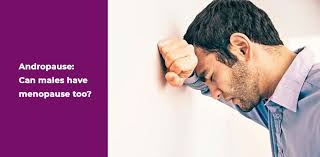Andropause, or male menopause, affects millions of men naturally. A progressive fall in testosterone levels can affect physical and emotional health….
Male menopause, or andropause, occurs naturally as men age. This progressive drop in testosterone, the male hormone, can affect physical and emotional health. While menopause is more well-known, andropause affects millions of men globally. To comprehend this lesser-known ailment, we will discuss andropause symptoms, causes, and therapies.
Andropause symptoms:
Andropause is progressive and lasts years. Starting in the late 40s or early 50s, it can last into the 60s or 70s. Andropause symptoms are typically mild and mistaken for aging. However, these symptoms can greatly impair a man’s quality of life and must be recognized. Common andropause symptoms include:
Libido decrease: One of the most prominent signs of andropause is a decrease in libido. This is because testosterone levels, which maintain sexual desire in men, are falling.
Erectile dysfunction: Low testosterone levels can make erections difficult. This can be frustrating and hurt a man’s self-esteem and relationships.
Fatigue: Many guys going through andropause feel tired. This can make regular duties difficult and affect their attitude.
Male muscle loss: Testosterone maintains muscle mass. During andropause, men may lose muscular mass, making physical activity tougher.
Decreased testosterone can cause irritation, mood swings, and sadness.
Andropause can cause hot flushes in men too. Warmth can be uncomfortable and disrupt normal life.
Causes of Andropause:
Andropause is caused by testosterone reduction as men age. However, other health issues may cause this reduction. Common causes of andropause include:
Hypogonadism: The pituitary gland or testes malfunction, causing low testosterone production.
Diabetes, obesity, and chronic liver or kidney disease can decrease hormone production and cause andropause.
Andropause symptoms can be caused by prostate cancer, depression, and high blood pressure medicines that affect testosterone production.
Lifestyle factors: Poor food, lack of exercise, excessive alcohol intake, and smoking can lower testosterone levels and raise andropause risk.
Treatments for Andropause:
Fortunately, there are some effective andropause treatments that can manage symptoms and increase well-being. Common male menopause therapies include:
TRT: Synthetic testosterone injections, gels, patches, or pellets are the most popular andropause treatment. This stabilizes hormones and reduces poor libido, lethargy, and mood swings.
Lifestyle changes: Regular exercise, a balanced diet, limiting alcohol, and quitting smoking can help manage andropause symptoms and improve health.
Counseling: Andropause can affect men’s mental health. Men can handle mood fluctuations and depression by seeking counseling or therapy.
Antidepressants and erectile dysfunction drugs may be administered to treat andropause symptoms.
Remember that every man’s andropause is distinct. Others may have severe symptoms that affect their everyday life, while others have minimal symptoms. Proper diagnosis and therapy require medical assistance.
Conclusion
The natural fall in testosterone, the principal male hormone, causes andropause, which affects men’s physical and emotional health. Libido loss, erectile dysfunction, weariness, muscle loss, mood changes, and heat flushes are symptoms. The main cause is the natural drop in testosterone levels as men age, with other health issues contributing. Poor diet, lack of exercise, excessive alcohol, and smoking can also contribute.
Andropause treatments include testosterone replacement therapy (TRT), lifestyle adjustments such regular exercise, a balanced diet, lowering alcohol, and stopping smoking, and counseling or therapy to help men cope. Andropause symptoms may be treated with medication. Proper diagnosis and therapy require medical assistance. In conclusion, andropause affects millions of men globally, compromising their health and quality of life.




